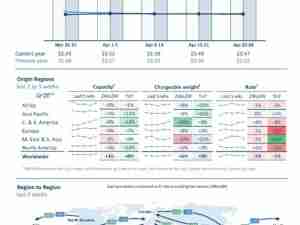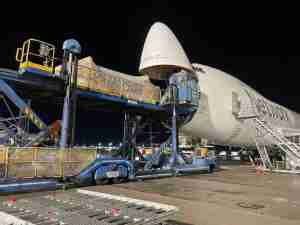Boeing Co. burned through $3.93 billion in cash in the first quarter, a less dramatic drain than analysts had predicted, as the embattled planemaker continues to slow output to get a handle on its manufacturing issues.
The company reported an adjusted loss per share of $1.13, and revenue of $16.57 billion in the first three months, according to a statement on Wednesday. Boeing, which didn’t provide an earnings guidance for the year, rose as much as 4.2% in premarket US trading after the figures.
Boeing’s first three months of the year have been overshadowed by the fallout from a near-catastrophic accident on Jan. 5 that’s upended the company’s manufacturing, financials and management. Chief Executive Officer Dave Calhoun, who plans to step down by the end of the year, told employees in a memo that Boeing is “leaving no stone unturned” as it reworks its factories, encourages workers to point out defects and slows its system to identify faults in its processes.
“Near term, yes, we are in a tough moment,” Calhoun said in the memo. “Lower deliveries can be difficult for our customers and for our financials. But safety and quality must and will come above all else.”
Slower Production
During the quarter, the 737 program slowed production below 38 a month, Boeing said. That’s the cap mandated by regulators while Boeing works on its improvements. The planemaker ended the reporting period with $7.5 billion in cash and short-term securities, down from $16 billion at the start of the year. The company said it still has access to $10 billion in undrawn credit.
Boeing had already cautioned a few weeks ago that it would suffer a cash outflow of as much as $4.5 billion in the quarter. By that measure, the earnings release offered a respite at a time when little has gone Boeing’s way.
“Well it could have been worse,” said Robert Stallard, an analyst at Vertical Research Partners, in a note to investors. “While the loss and the cash outflow are not as bad as feared, the company is still clearly facing some serious challenges in the Commercial Aircraft division that will take some fixing.”
Its cash use wasn’t as bad as the $4.4 billion outflow that analysts had expected, based on data compiled by Bloomberg. Sales and earnings were also better than consensus estimates. The results were boosted by an operating profit at Boeing’s defense division, which had posted negative margins in recent quarters.
The Defense & Space subsidiary turned a corner in the quarter, reporting $151 million in earnings from operations after a loss a year earlier, despite booking $222 million in losses on some fixed-price contracts. The Global Services unit had a profit of $916 million, also an improvement from the year-earlier figure.
Boeing has faced an onslaught of bad news since a door plug blew out of a two-month old 737 Max in early January, eroding confidence in its manufacturing. The company has been buffeted by a leadership exodus, civil and criminal investigations, Congressional hearings and whistleblower revelations. Its 737 factory has slowed to a crawl as the planemaker cuts down on out-of-sequence work and drafts a 90-day plan to bolster its quality and safety for US regulators.
Regulatory Oversight
Boeing’s recovery hinges in no small part on input from the Federal Aviation Administration, which has tightened oversight of the company in the wake of the accident. Measures include a capped output of the 737, and inspectors on the ground at Boeing factories reviewing manufacturing.
Shares of Boeing have lost more than a third in value since the start of the year, the worst performer on the Dow Jones Industrial Average. Rival Airbus SE, which reports earnings on Thursday, has gained 18% in the period.
“It is hard to think what the existing, but now temporary, management can say on the call to make markets feel a lot better about Boeing,” Nick Cunningham, analyst with Agency Partners, said in a note to clients before the results were published.
The manufacturer is being squeezed by reduced revenue and the rising cost of keeping its suppliers afloat until its production system can smoothly handle higher manufacturing rates again.
Boeing plans to build 737s at a very slow pace during the first six months of 2024, then accelerate to its previous 38-jet monthly rate later in the year, Chief Financial Officer Brian West said last month. As of March 1, it shifted inspections of the narrowbody frames to Wichita, Kansas, where they are built by supplier Spirit AeroSystems Holdings Inc.
Fuselage Shipments
Fuselage shipments have fallen as a result, adding to Spirit’s own financial strains. Boeing is providing a $425 million funding infusion, which Spirit is to repay over the next six months, the aerostructures supplier announced in a filing after the close of trading Tuesday.
The move could also signal that the planemaker is preparing for long, drawn-out negotiations to buy back its former Wichita division, analyst Ken Herbert of RBC Capital said in a note. Bloomberg first reported Tuesday that the sides face protracted talks to spin off some Spirits factories to end customer Airbus.
“We’re going to watch cash very closely for the next couple of quarters,” said George Ferguson, analyst with Bloomberg Intelligence, citing the uncertainty as to whether more bad news could still lay ahead to spook investors.
“I don’t think you’ll get a bottom until you get a new CEO,” Ferguson said.








